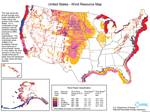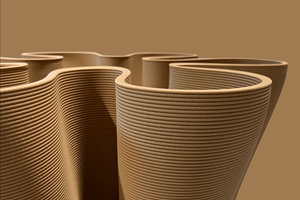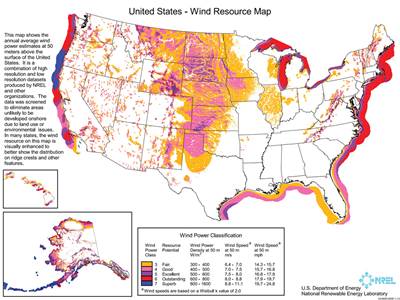What is carbon fiber's place in wind energy systems?
CW Conferences director Scott Stephenson shares insights fro the recent 2011 Carbon Fiber conference (Dec. 5-7, 2011, in Washington, D.C.) presented by Nirav Patel, senior lead engineer of GE Energy-Manufacturing Technology (Greenville, S.C.).
You don’t have to study the carbon fiber manufacturing market for very long to learn a few basic tenets. The first is that the aerospace market was, is and will continue to be critical to the market’s growth and maturation. The second is that in the wind energy market, even by conservative estimates, carbon fiber consumption is poised to dwarf aerospace consumption over the next 10 years.
The reason for this is scale. Larger turbines with longer blades are more efficient (see “Learn More,” below). However, as wind blades get longer, weight plays an increasingly negative role in turbine efficiency. Reducing weight while maintaining strength and stiffness is paramount, if efficiency is to be optimized. Accordingly, some blade structures that are typically molded of glass fiber composites, such as spar caps, are being converted to carbon fiber to take out weight. There are, however, challenges fundamental to carbon fiber supply that discourage the application of carbon fiber in wind blades. The biggest two are consistency of fiber supply and — no surprise to composites industry professionals — fiber cost.
Highlighting these challenges at the 2011 Carbon Fiber conference (Dec. 5-7, 2011, in Washington, D.C.) was Nirav Patel, senior lead engineer of GE Energy-Manufacturing Technology (Greenville, S.C.). Patel’s insights are significant because GE Energy is the largest wind turbine supplier in the U.S. What GE Energy does with carbon fiber is sure to have a significant impact on the overall supply of carbon fiber to the composites industry.
Patel reported that GE Energy currently uses large-tow (≥24K), standard-modulus carbon fiber, supplied by Mitsubishi Rayon Co. Ltd. (Tokyo, Japan) and Zoltek Inc. (St. Louis, Mo.), in unspecified primary structures on next-generation 48.7m/160-ft blades installed on its 1.6-100 turbine — 1,600 of which are expected to be constructed using carbon fiber. In 2012 alone, Patel said, GE Energy expects to consume approximately 3,000 metric tonnes (6.614 million lb) of carbon fiber.
When massive, highly stressed composite structures are molded at such high volumes, obvious demands are placed on the manufacturer. Patel noted that both the fiber and the resin must be of high quality, and the manufacturing process must be fast, yet consistent and repeatable. One of GE Energy’s biggest challenges — and one which Patel exhorted carbon fiber suppliers in the audience to address — is to establish a large, reliable supply of ≥24K tow, standard-modulus carbon fiber. This has proven particularly difficult so far.
On the production floor, there are more challenges. GE Energy is trying to migrate to faster, less laborious manufacturing processes and hopes to form an enabling relationship with a machinery supplier. Patel talked about the pros and cons of resin infusion, vacuum bagging of prepreg, automated ply placement and pultrusion processes. Most blade manufacturers use resin infusion because it offers relatively inexpensive tooling and raw materials, but finished products often have mechanical properties inferior to prepreg. Vacuum bagging of prepreg provides uniform resin distribution with good fiber alignment, but the trade-off is a lengthy preconsolidation step and high material cost. Automated ply placement increases quality and consistency, but at a high capital equipment cost. Further advancements in composites manufacturing will be required to achieve high production rates at an affordable cost, Patel said.
One measure of carbon fiber quality, he noted, is finished product quality — no wrinkles, no dry zones, no delamination and good fiber alignment. GE also looks closely at the porosity of finished products. “Typically,” he said, “the presence of porosity has been shown to have a strong correlation with certain mechanical properties, such as compressive strength, transverse tensile strength and interlaminar shear strength. However, tensile strength properties, which are determined almost exclusively by the fiber properties, are relatively unaffected by the presence of porosity.” The previously mentioned porosity-sensitive mechanical requirements can be optimized, he believes with next-generation resins, which GE Energy also needs to reduce cycle time and improve wetout. One option, Patel noted, might include the use of nano-enhanced matrix resins.
On the subject of carbon fiber cost, Patel noted that carbon fiber for wind blades costs $20/kg to $30/kg, which is 15 to 20 times greater than the cost of E-glass fiber. Patel told conference-goers that the challenges of supply and material cost are considered “show stoppers” that, unless overcome, will preclude further application of carbon fiber in GE Energy blades.
Related Content
Welding is not bonding
Discussion of the issues in our understanding of thermoplastic composite welded structures and certification of the latest materials and welding technologies for future airframes.
Read MorePlant tour: Airbus, Illescas, Spain
Airbus’ Illescas facility, featuring highly automated composites processes for the A350 lower wing cover and one-piece Section 19 fuselage barrels, works toward production ramp-ups and next-generation aircraft.
Read MoreSulapac introduces Sulapac Flow 1.7 to replace PLA, ABS and PP in FDM, FGF
Available as filament and granules for extrusion, new wood composite matches properties yet is compostable, eliminates microplastics and reduces carbon footprint.
Read MorePlant tour: Teijin Carbon America Inc., Greenwood, S.C., U.S.
In 2018, Teijin broke ground on a facility that is reportedly the largest capacity carbon fiber line currently in existence. The line has been fully functional for nearly two years and has plenty of room for expansion.
Read MoreRead Next
Offshore wind: How big will blades get?
Explosive growth in offshore wind farms will push the limits of blade engineering as manufacturers pursue massive designs that will harvest more megawatts.
Read MoreNext-gen fan blades: Hybrid twin RTM, printed sensors, laser shock disassembly
MORPHO project demonstrates blade with 20% faster RTM cure cycle, uses AI-based monitoring for improved maintenance/life cycle management and proves laser shock disassembly for recycling.
Read MoreCutting 100 pounds, certification time for the X-59 nose cone
Swift Engineering used HyperX software to remove 100 pounds from 38-foot graphite/epoxy cored nose cone for X-59 supersonic aircraft.
Read More








